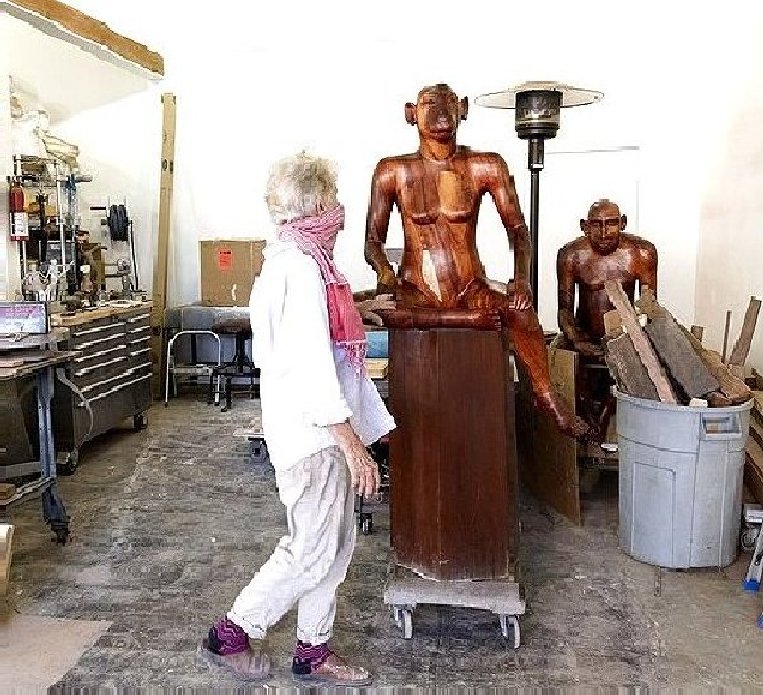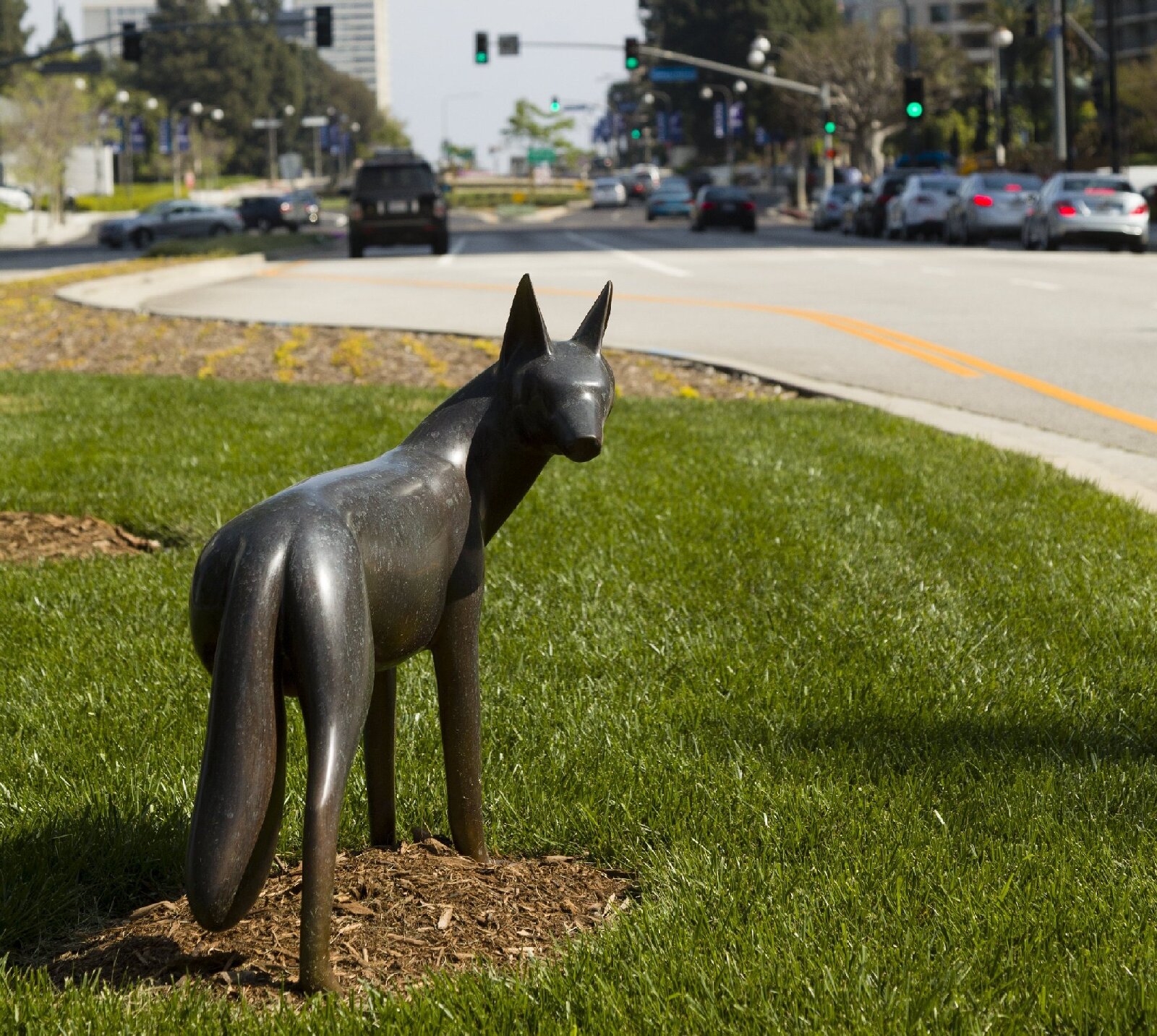“Art, whatever it takes” – The RomeArtProgram has made a series of interviews with Artists living in Italy, the USA, and the UK, to know their feelings during these times of emergency.
Gwynn Murrill – Sculptor from Los Angeles
Rome Prize winner at American Academy Rome and Honorary board member at Rome Art Program.
RomeArtProgram: Where do you live ? What is your background?
Gwynn: I was born in Michigan and raised in San Diego, Ca. I received an MFA in Painting from UCLA in 1972. During that time I became interested in sculpture which has become my medium of choice.
RAP: In your opinion is there a “creative method”?
Gwynn: I am not sure what is a creative method. It comes naturally to me to make things with my hands. I love clay, I love painting with lots of color. I found out that I love working wood, marble, anything that I can carve.
RAP: The “lock down moment” can set you on the path of some important change(s) in your creativity and style…Has this happened to you ?
Gwynn: When the covid hit the USA around mid March, I was working towards a survey exhibition of my sculpture. I was finishing a couple of works for the show that was to open in May. So I wasn’t concentrating very much on what was going on outside of my studio until I realized the the exhibition couldn’t happen. Now I am not sure what I am thinking about. It is a confusing time.
RAP: What normally inspires you? Which is the most important inspirational source you have found in Rome?
Gwynn: The layers of civilization that were shown to me by art historians when I was at the American Academy were fascinating. They would take us down into the bowels of ancient buildings and point out the different eras. Of course, some of my favorite walks were through piazzas with fountains and sculptures.
One of my most favorites is the expansive Piazza Navona with the Bernini Fountain. My favorite museum is the Villa Giulia which holds a wonderful collection of Etruscan civilization artworks. It is difficult to pinpoint the inspirations when everywhere you look is a feast for the eyes
RAP: Is there a difference in working in Rome for an artist? What art medium do you prefer to work in?
Gwynn: When I went to the American Academy in 1979, I wanted to work in marble. ( For 10 years I had been working with wood.) I was ready to see what marble was like. I had to go to Carrara to buy marble and bring it to the Academy. I learned about the tools to use. Then with use of a compressor at the academy I carved two sculptures, one of a life-size dog and one of a cat. I loved carving marble. Though it took me most of my year at the academy to finish the sculptures. The main difficulty I found working in Rome was to call a hardware store to ask if they had a certain item and then find out when I arrived that they didn’t have it. Or that they were closed for the midday hour siesta. It was difficult for me to learn to get my timing right.
RAP: Specific events and historical conditions have a significant role in the creative process; how does this pandemic emergency affect the Arts?
Gwynn: In Los Angeles all of the museums have been closed for 6 months now. The galleries are open for appointments, but no openings. They put up the exhibitions on line and show interviews with their artists. Kind of interesting I have noticed that galleries are presenting different artists than before the pandemic. Less cutting edge and more thoughtful artwork.
RAP: How are you feeling at this difficult moment and what made you feel this way? …are you optimistic for the future?
Gwynn: Here in the US were are focused on the upcoming presidential election and the pandemic at the same time. Our world feels turned upside-down by a president who seems to be trying to instigate chaos by dividing the races. He hasn’t been helpful during the pandemic, so we see no possible end to it. It is very depressing and frightening.
RAP: What can Art contribute to history? Will “Art save us”?
Gwynn: We artists must continue to make art to save ourselves first. History will follow.
RAP: What is your most ambitious dream?…and the greatest sacrifice that you have made for your Art?
Gwynn: I don’t know what I may have sacrificed for my art. I suppose I could look back and think about what I could have done differently. But what would that be? This is the life I chose. I am happy that I get to make things that are in my imagination and that surprise me when they actually exist. Sometimes it takes time before I understand what I have made.
RAP: Recently, the artistic and cultural message of Italy and Rome was reemerging as a great “work in progress”, Is this your point of view?
Gwynn: Rome will always be there. It may be torn down, it may become covered with new modern buildings, but all of the changes will add to the history of this amazing city.
RAP: Which is your favorite Italian, or Roman, place(s) of art (Museum, Gallery, Monument…)?
Gwynn: My favorite museum is the Villa Giulia. which holds a wonderful collection of Etruscan civilization artworks.
My favorite Italian work of art is Donatello’s David. I first saw it in 1963. I was a student and I didn’t really understand sculpture very well since I hadn’t seen many sculptures in my life.
I saw Michelangelo’s David first. I thought it was beautiful, and extraordinary, but distant.
When I saw Donatello’s David I realized that a sculpture can imply sensitivity and emotion.
I still feel that lesson to this day. I can’t really pinpoint which period of Italian art I like best. Whenever I visit Italy I focus on different periods. However, I always go to the Forum to the Palatine Hill.
RAP: How has Rome personally influenced you as an artist and a person?
Gwynn: Every time I have visited Rome I have learned new things about it. And remembered old things that I had forgotten. My husband and I went with Carol Robb the first year of the Rome Art Program. I love to watercolor when I go on vacations. But I am not very good at working in public. I thought that it would be good for me to be in a group where I could feel less obvious.. It was really a lot of fun going places all over the Rome making watercolors. It is interesting to sit in one place for awhile and take in the atmosphere while deciding what to paint. It is a way of slowing down to see where you are and really looking in order to make a painting. I can remember so many more details now about the areas where I painted. I would love to do it again.
RAP: What’s your goal? What role does the artist have in society? Any final thoughts and advice?
Gwynn: My goal is to allow myself to make art without any pressure to satisfy others, even myself. If I don’t understand what I am doing, it shouldn’t worry me because it will be a surprise. The role that artist has in society is to express ideas that come from inside or outside themselves. The ideas swim around the their brains and come out through their fingers or mouths. In some ways art reflects the society that artists are living in at the time. I depend on the history of art to help me learn about the mood of what was happening during the time the artwork was made.
www.murrillsculpture.com
RomeArtProgram is ready to bounce back!
___________________
RomeArtProgram
#romeartprogram
Art-as-Power
.


